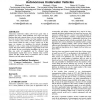Free Online Productivity Tools
i2Speak
i2Symbol
i2OCR
iTex2Img
iWeb2Print
iWeb2Shot
i2Type
iPdf2Split
iPdf2Merge
i2Bopomofo
i2Arabic
i2Style
i2Image
i2PDF
iLatex2Rtf
Sci2ools
109
Voted
MOBICOM
2006
ACM
2006
ACM
Electromagnetic communications within swarms of autonomous underwater vehicles
Autonomous underwater vehicles (AUVs) have great value as platforms for sensors. While traditional AUVs have been large platforms that tend to operate alone or in very small groups, there has been recent interest in using very large numbers of small AUVs in swarms. Such swarms offer the potential to increase sensor density within the same, or lower, system cost. In this paper, we compare via simulation the network throughput obtained in such a swarm using electromagnetic and acoustic signals. The results of these simulations suggest that, for the same raw channel bit rate, much higher throughputs (by up to more than one order of magnitude) can be obtained using electromagnetic signals than can be obtained using acoustic signals, and that careful choice of parameters such as carrier frequency can help optimize performance. Categories and Subject Descriptors C.2.1 [Computer-Communication Networks]: Network Architecture and Design – wireless communication General Terms Performance, des...
| Added | 14 Jun 2010 |
| Updated | 14 Jun 2010 |
| Type | Conference |
| Year | 2006 |
| Where | MOBICOM |
| Authors | Michael R. Frater, Michael J. Ryan, Robin M. Dunbar |
Comments (0)

